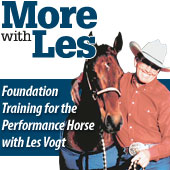
33rd in a series
Last issue, Les reviewed the “reverse arc” and the nature of right- and left-footed horses. We move now deeper into lateral movement with some new exercises.
Objective
– To start teaching your horse to let you move his whole body laterally
– To start teaching your horse to let you move his hip
– To learn to do both of these things without letting the shoulder lead the movement
– To improve your back-up or overcome resistance if you’re having problems
– To learn to feel whether your horse is straight from head to tail and learn how to correct him if he is not
– To learn how to back your horse easily and softly
Things to Concentrate On
As you continue working on body control your movement should become more and more automatic. When you first learn something, you have to do a lot of thinking about what you are doing and how you need to do it, what to do if it doesn’t work and so forth and so on. But your main goal is to get to the point where you no longer need to think, where your subconscious takes over and your body automatically reacts. If you’ve ever studied any one-on-one competitive sports like karate or fencing, or a partnered activity like pairs figure skating or ballroom dancing, then you know how much time is devoted to learning the individual moves. You are required to practice them over and over and over again until you don’t think about them anymore, they just happen on their own, as natural reactions.
As you work at putting your horse’s body in different positions you want to stay at it until giving your cues becomes and automatic response to your thought – I call it developing “muscle memory”. When you think, “move shoulders,” the cue should just happen, if you still have to go through a mental checklist: “rein over and up, inside leg,” you are not ready to move on. You also want to be able to feel it whenever you are getting resistance from your horse.
Alignment is a good place to start to develop that feel, but as you pay more attention you’ll find that in everything you do, there is probably one body part that could be a little
lighter or a little softer, a little better positioned, and your goal is to identify it and fix it … without thinking about it.
So stay with every exercise until it is “thoughtless”. Visualizing the exercise helps a lot of people.
EDITOR’S NOTE: More with Les is a regular California Horsetrader column. Les Vogt has won more than 15 World Championships, including two wins at the NRCHA Snaffle Bit Futurity. Although Les still rides and occasionally shows, his focus is giving clinics around the world and developing products for the performance horseman. To learn more about Les and to see his clinic schedule, visit: www.lesvogt.com
Leave a Comment
All fields must be filled in to leave a message.